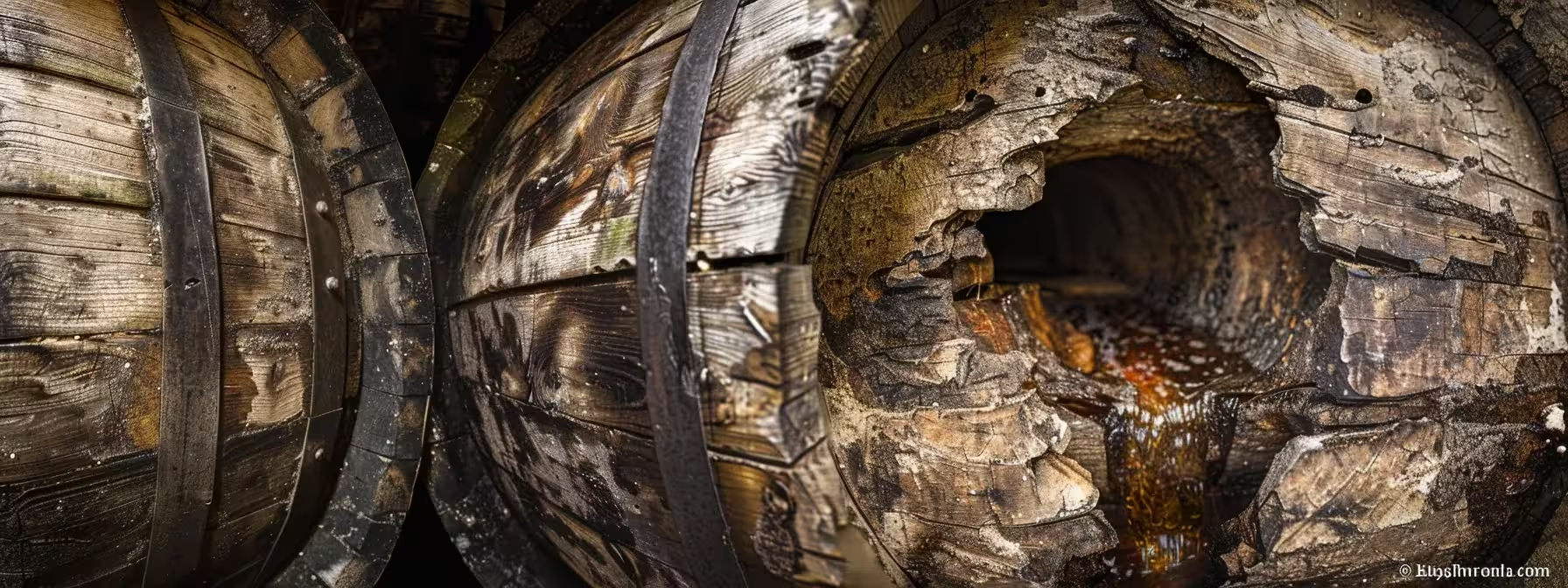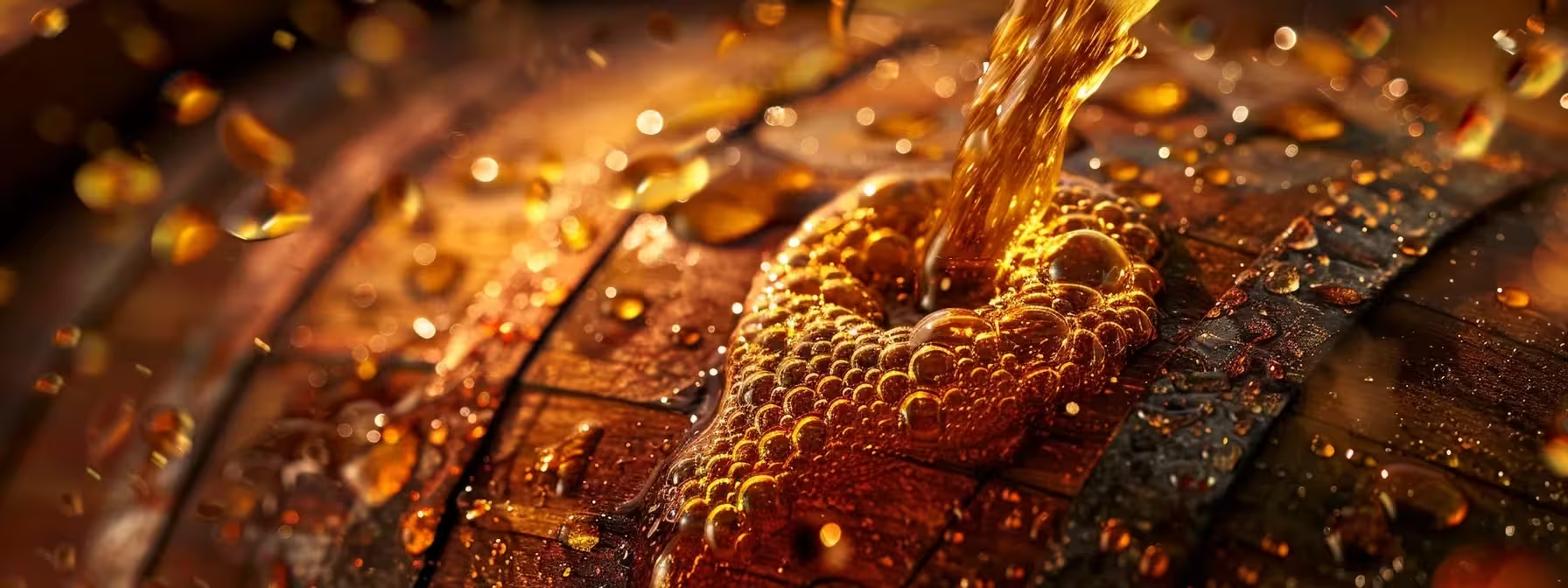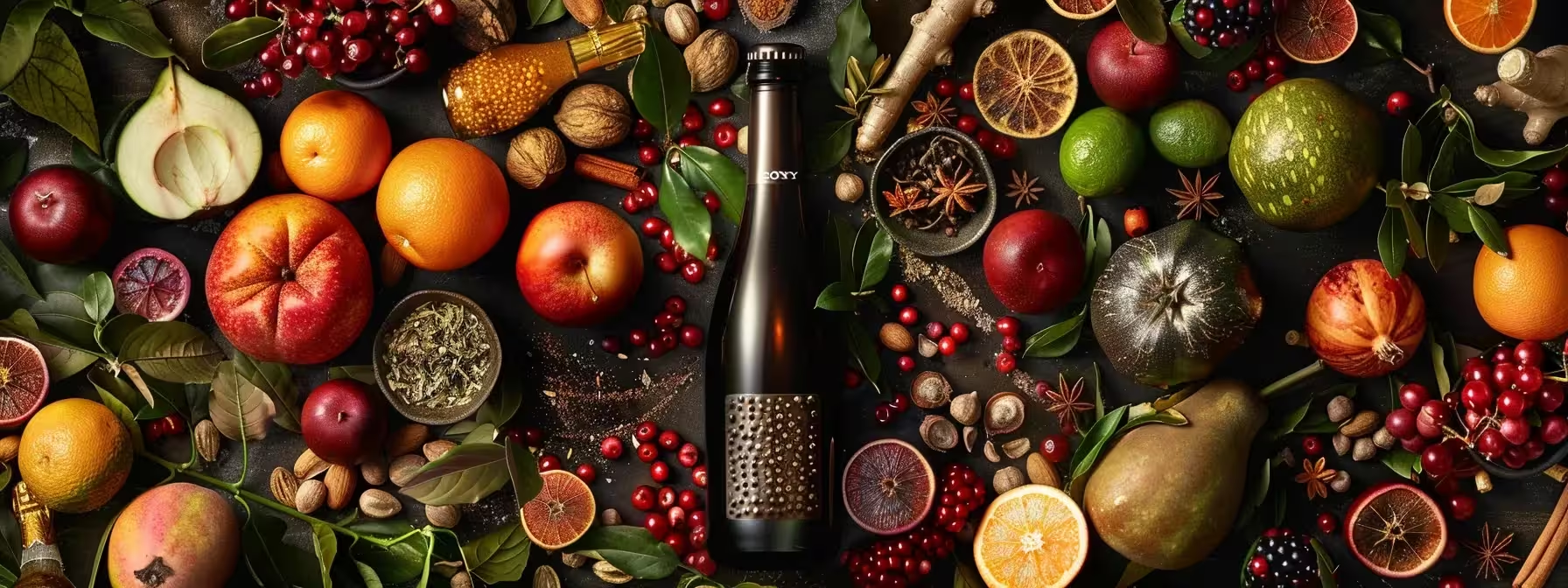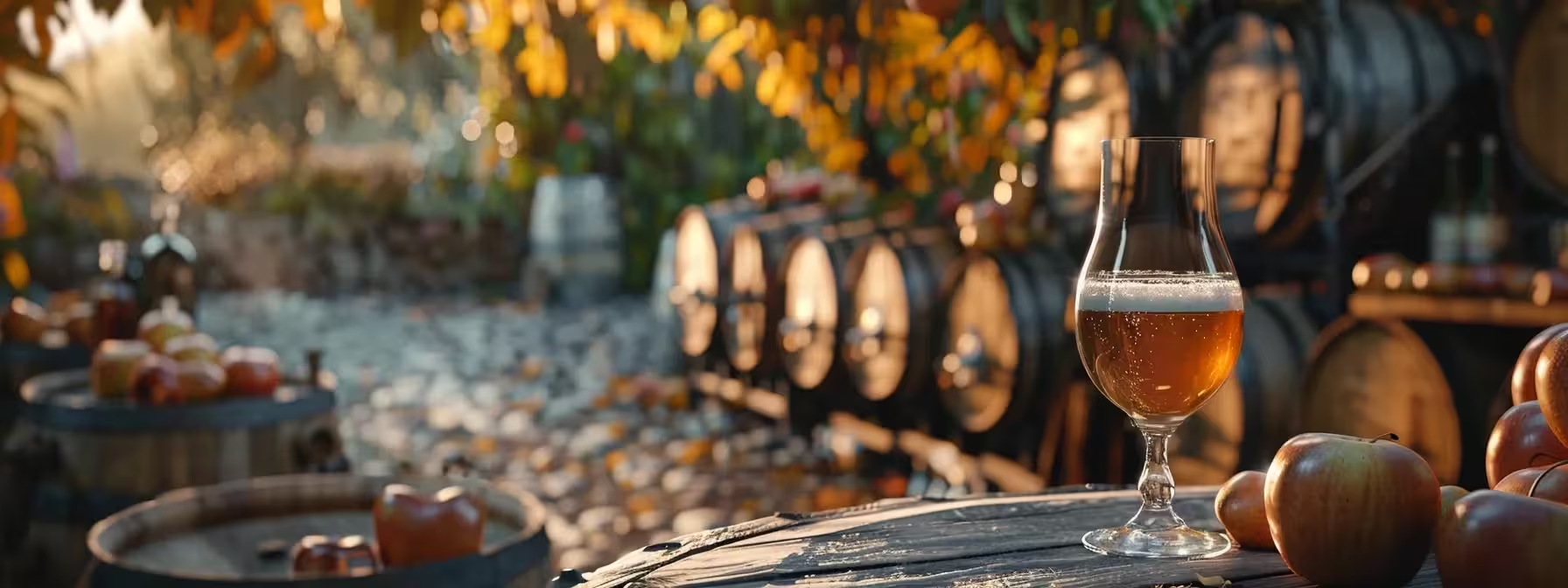
Have you ever wondered how time transforms the flavor of cider? At Waldschänke Ciders, we explore the fascinating journey of aging cider, from orchard to glass. This article delves into the chemical transformations that occur during maturation, the impact of barrel aging, and the optimal conditions for developing complex flavors. By understanding these processes, you’ll gain a deeper appreciation for aged ciders and learn how factors like sugar content and nutrients influence the final product. Whether you’re a cider enthusiast or simply curious, this guide will enhance your tasting experience and help you make informed choices when you order online.
Key Takeaways
- Cider aging transforms taste through fermentation, maturation, and interaction of yeast, acid, and time
- Barrel aging imparts unique flavors and aromas, influenced by wood type and previous use
- Temperature, humidity, light, and oxygen control are crucial for optimal cider aging conditions
- Well-aged ciders exhibit balanced flavors, smooth mouthfeel, and complex aromas
- Aged ciders pair well with strong cheeses, roasted meats, and apple-based desserts
Understanding the Aging Process in Cider

The aging process in Waldschänke Ciders transforms its taste and character. This section explores the journey from fermentation to maturation, examining factors that influence cider aging. It also compares cider aging with other beverages, highlighting how yeast, acid, and time interact to create unique flavors in this fermented drink. Order Online
The Journey From Fermentation to Maturation
Cider’s journey from fermentation to maturation begins with the conversion of apple sugars into alcohol and carbon dioxide. Yeast consumes the sugars, producing cider with an alcohol content typically ranging from 2% to 8%. During this process, the cider develops its initial flavor profile, influenced by the apple varieties used and the fermentation conditions.
As the cider ages, it undergoes further transformations. Barrel aging can impart subtle flavors from the wood, similar to wine aging. The interaction between alcohol, water, and remaining sugars continues to evolve the cider’s taste and aroma. This maturation process can last anywhere from a few weeks to several months, depending on the desired flavor complexity and style of cider being produced.
Factors Influencing How Cider Ages
Several factors influence how cider ages, including the characteristics of the apple juice used, the fermentation process, and storage conditions. The type and quality of apples directly impact the cider’s flavor profile and aging potential. Fermentation temperature and duration affect the development of alcohol by volume and the formation of complex flavors. Storage conditions, such as temperature and exposure to light, play a crucial role in the maturation process.
The presence of bacteria and wild yeast can also influence cider aging, contributing to unique flavors and aromas. Some cidermakers intentionally introduce specific strains of bacteria to create sour or funky notes, similar to certain beer styles. The interaction between these microorganisms and the cider’s components continues throughout the aging process, resulting in a more complex and nuanced alcoholic beverage. The following factors play a significant role in cider aging:
- Apple variety and quality
- Fermentation temperature and duration
- Storage conditions (temperature, light exposure)
- Presence of bacteria and wild yeast
- Alcohol content
Comparing Cider Aging With Other Beverages
Cider aging shares similarities with other fermented beverages, particularly wine and beer. Like wine, cider undergoes malolactic fermentation, where malic acid converts to lactic acid, softening the overall acidity. This process, along with the interaction between ethanol and fruit compounds, contributes to the development of complex flavors and aromas in aged ciders.
However, cider aging differs from beer and wine in several aspects. Unlike beer, which often relies on hops for preservation, cider depends on its natural acidity and alcohol content to maintain stability during aging. Additionally, cider retains more of its fruit character throughout the aging process, as the apple flavors continue to evolve and integrate with other compounds. The following factors distinguish cider aging from other beverages:
- Retention of fruit character
- Reliance on natural acidity for preservation
- Unique interaction between apple compounds and ethanol
- Slower carbon dioxide dissipation compared to beer
- Potential for extended aging periods, similar to certain wines
Chemical Transformations During Cider Maturation

During cider maturation, chemical transformations significantly impact flavor and character. Changes in sugars and acidity over time alter the cider’s taste profile. The development of aromatic compounds contributes to complex bouquets. Tannins play an evolving role, influencing mouthfeel and astringency. These processes involve pressure changes, pectin breakdown, foam formation, carbon dioxide release, and interactions within the liquid matrix.
Changes in Sugars and Acidity Over Time
As cider ages in the tank, the sugars present in the juice undergo significant changes. The residual sugars from cider apples continue to break down, leading to a gradual decrease in sweetness over time. This process affects the overall balance of flavors, with the cider potentially becoming drier as it matures.
Simultaneously, the acidity of the cider evolves during aging. Malic acid, naturally present in apples, slowly converts to lactic acid through malolactic fermentation. This transformation softens the cider’s sharp acidity, resulting in a smoother, more rounded mouthfeel. The use of sulfites can influence this process, potentially slowing down the acid conversion and preserving some of the cider’s original bright, crisp character.
Development of Aromatic Compounds
The aging process in cider leads to the development of complex aromatic compounds. As the cider matures, enzymes like pectinase break down pectin, releasing aromatic precursors. This breakdown contributes to the evolution of flavors and aromas, enhancing the cider’s overall sensory profile.
During maturation, the interaction between sugars, acids, and yeast produces various esters and phenolic compounds. These chemical transformations result in a range of aromatic notes, from fruity and floral to spicy and earthy. The presence of glucose and its conversion to acetic acid can introduce subtle vinegar-like notes, similar to certain winemaking processes, adding depth to the cider’s bouquet.
The Evolving Role of Tannins
Tannins play a crucial role in the aging process of apple cider, influencing its flavor, mouthfeel, and overall character. As cider matures, the tannins extracted from apple skins and seeds undergo chemical transformations, softening their astringent qualities and contributing to a smoother taste profile. The pH of the cider affects tannin solubility, with lower pH levels typically leading to increased tannin extraction and retention.
The use of sulfur dioxide in cider production can impact tannin evolution during aging. While sulfur dioxide acts as a preservative, it also affects the oxidation of tannins, potentially slowing down their polymerization. This process influences the cider’s final flavor and texture, with well-aged ciders often exhibiting a more balanced tannin structure. Pasteurization techniques may also affect tannin development, as heat treatment can alter the chemical composition of these compounds in apple cider.
Flavor Evolution in Aged Cider

Aging transforms cider’s flavor profile, enhancing complexity through enzyme activity and lactic acid bacteria. This process balances sweetness, acidity, and tannins, resulting in mature ciders with distinct flavor notes. As cider ages in kegs or bottles, cells continue to interact, developing a rich tapestry of tastes that evolve over time.
How Aging Enhances Flavor Complexity
Aging enhances flavor complexity in cider through various chemical processes. As cider matures, compounds like acetaldehyde and fructose interact, creating new flavor profiles. The presence of lees, consisting of dead yeast cells and other particles, contributes to the development of unique tastes and aromas.
During aging, Saccharomyces yeast continues to work, albeit slowly, converting residual sugars and producing subtle flavor changes. The controlled use of sulfur compounds can influence this process, helping to preserve desirable flavors while preventing oxidation. These interactions result in a more nuanced and layered flavor profile, distinguishing aged ciders from their younger counterparts.
- Chemical reactions between acetaldehyde and fructose
- Influence of lees on flavor development
- Slow fermentation by Saccharomyces yeast
- Impact of sulfur compounds on flavor preservation
- Development of complex, layered taste profiles
Common Flavor Notes in Mature Ciders
Mature ciders often develop complex flavor notes as they age. Through the process of racking, which involves transferring the cider between containers, flavors become more refined and integrated. Common flavor profiles include hints of caramel, vanilla, and oak, particularly in ciders aged in wooden barrels.
The aroma of aged ciders evolves to include nuanced notes of dried fruits, spices, and sometimes a subtle earthiness. As sucrose breaks down over time, the cider’s sweetness may decrease, leading to a drier finish and allowing more subtle flavors to emerge. These complex flavor and aroma combinations contribute to the unique character of mature ciders.
Balancing Sweetness, Acidity, and Tannins
As cider ages, the balance between sweetness, acidity, and tannins evolves. The breakdown of complex sugars in apple concentrate influences the perceived sweetness, while the acidity softens through malolactic fermentation. Tannins from oak aging contribute to the overall flavor profile, creating a more harmonious and sophisticated taste.
The microbiology of aging cider plays a crucial role in this balance. Yeast and bacteria continue to work, producing compounds like ethyl acetate that add complexity. Sediment formation during aging can also affect the flavor balance, often resulting in a cleaner, more refined taste. The following factors contribute to the balance of flavors in aged cider:
- Sugar breakdown and concentration changes
- Malolactic fermentation softening acidity
- Tannin extraction from oak aging
- Microbial activity producing flavor compounds
- Sediment formation and its impact on taste
The Impact of Barrel Aging on Cider Character

Barrel aging significantly influences cider’s character, enhancing its complexity and depth. This section explores the selection of appropriate barrels, the impact of different wood types on flavor and aroma, and effective aging techniques. Understanding these factors helps cidermakers create unique profiles, balancing the natural apple flavors with the nuances imparted by wood aging.
Selecting the Right Barrel for Aging
Selecting the right barrel for aging cider involves considering factors such as wood type, previous use, and sterilization methods. Cidermakers must balance the desired flavor profile with the need to prevent contamination from acetic acid bacteria. The quantity of barrels and their size also influence the aging process, affecting the cider’s exposure to wood and oxygen.
Proper barrel preparation includes sterilization techniques that maintain the wood’s integrity while ensuring food safety. Cidermakers often use potassium metabisulfite solutions to clean barrels, which also helps control microbial growth. The nitrogen content of the cider and barrel environment plays a role in flavor development during aging. Careful selection and preparation of barrels contribute to the final cider’s character:
- Wood type and previous use impact flavor impartation
- Sterilization prevents unwanted bacterial growth
- Barrel size affects wood contact and oxidation rates
- Nitrogen levels influence fermentation and aging processes
- Potassium-based solutions aid in barrel preparation
Influence of Wood Types on Flavor and Aroma
The type of wood used in barrel aging significantly influences the flavor and aroma of cider. Oak barrels, commonly used in cider production, impart distinct flavors such as vanilla, spice, and toast. The heat treatment applied during barrel making affects the intensity of these flavors, with higher temperatures resulting in more pronounced wood characteristics.
Other wood types, such as chestnut or acacia, offer unique flavor profiles to cider. Chestnut can introduce nutty and earthy notes, while acacia may add floral and honey-like aromas. Cidermakers consider these wood influences alongside the natural apple flavors when deciding on filtration methods and the use of preservatives like benzoic acid to achieve the desired balance in the final product.
Techniques for Effective Barrel Aging
Effective barrel aging techniques for cider include careful monitoring of temperature and humidity. Cidermakers use airlocks to control oxygen exposure, preventing the formation of vinegar while allowing controlled oxidation. The mixture of cider and wood compounds develops over time, with periodic sampling helping to determine optimal aging duration.
Strain selection plays a crucial role in barrel aging, as certain yeast strains thrive in wood environments. Some cidermakers introduce added sugar during aging to encourage secondary fermentation, enhancing complexity. Regular rotation of barrels ensures even exposure to wood elements, contributing to a balanced flavor profile in the final product.
Optimal Conditions for Aging Cider

Optimal conditions for aging cider involve precise control of temperature, humidity, light, and oxygen exposure. These factors, along with proper aging duration, significantly influence the cider’s flavor development. Careful management of these elements, including the use of siphons and pumps for transfer, and campden tablets for preservation, ensures the desired density and prevents unwanted growth of candida yeast, resulting in a high-quality aged cider.
Ideal Temperature and Humidity Settings
The ideal temperature for aging cider typically ranges between 50°F and 65°F (10°C to 18°C), with consistent monitoring using a thermometer. This temperature range allows for slow, controlled fermentation and flavor development without encouraging the growth of unwanted microorganisms like Brettanomyces. Cidermakers often use carboys for aging, as they provide a controlled environment and allow for easy monitoring of the cider’s progress using a hydrometer.
Humidity levels should be maintained between 50% and 70% to prevent excessive evaporation and contamination. Potassium metabisulfite can be used to control microbial growth and oxidation during the aging process. Proper humidity control helps preserve the cider’s quality and prevents the development of off-flavors. The following factors contribute to creating optimal aging conditions:
- Consistent temperature between 50°F and 65°F
- Humidity levels of 50% to 70%
- Use of carboys for controlled aging
- Regular monitoring with thermometers and hydrometers
- Application of potassium metabisulfite for microbial control
Managing Light and Oxygen Exposure
Managing light and oxygen exposure is crucial for optimal cider aging. Cidermakers often use dark bottles or opaque containers to protect the cider from light-induced oxidation, which can lead to off-flavors and haze formation. The cork used in bottling plays a vital role in controlling oxygen ingress, with high-quality natural corks allowing for minimal oxygen exposure while facilitating controlled autolysis.
Monitoring the cider’s volume during aging is essential, as changes can indicate oxidation or microbial activity. Regular measurements of dissolved oxygen help cidermakers maintain the ideal balance for flavor development. Some producers employ techniques such as topping up or using inert gases to minimize headspace, reducing the risk of excessive oxidation and preserving the cider’s intended character.
Determining the Appropriate Aging Duration
Determining the appropriate aging duration for cider requires careful monitoring of oxygen levels and regular sampling. Cidermakers use specialized stoppers to control oxygen exposure while allowing for periodic tasting. The aging process can range from a few months to several years, depending on the desired flavor profile and the cider’s initial characteristics.
Proper sanitation of pipes and equipment is crucial throughout the aging process to prevent contamination. Some producers employ centrifugation techniques to clarify the cider before final bottling, ensuring a consistent product. The decision to end the aging process is based on achieving the optimal balance of flavors, aroma, and mouthfeel, which varies depending on the cider style and producer’s goals.
Appreciating Aged Cider Through Tasting

Appreciating aged cider involves recognizing quality indicators, mastering tasting techniques, and understanding food pairings. This section explores how to identify traits of well-aged cider, methods for evaluating mature ciders, and strategies for pairing these complex beverages with complementary foods. These skills enhance the tasting experience and appreciation of aged ciders.
Identifying Quality Indicators in Aged Cider
Quality indicators in aged cider include a balanced flavor profile, smooth mouthfeel, and complex aroma. Well-aged ciders often exhibit a harmonious blend of apple notes, subtle oak influences, and secondary flavors developed during maturation. The absence of harsh acidity or overpowering tannins suggests a successful aging process, resulting in a refined and nuanced beverage.
Visual cues also play a role in identifying quality aged ciders. A clear, bright appearance without excessive sediment indicates proper filtration and stabilization. The color may deepen slightly with age, ranging from pale gold to rich amber, depending on the apple varieties used and the duration of aging. These visual characteristics, combined with the sensory experience, help connoisseurs appreciate the craftsmanship behind aged ciders.
Techniques for Tasting and Evaluating Mature Cider
Tasting mature cider involves engaging all senses to fully appreciate its complexity. Cider enthusiasts first observe the color and clarity, then gently swirl the glass to release aromas. A deep inhalation allows for the identification of primary apple notes and secondary flavors developed during aging. Tasters then take a small sip, allowing the cider to coat the palate, noting the balance of sweetness, acidity, and tannins.
Evaluating mature cider requires attention to its texture and finish. The mouthfeel should be smooth, with well-integrated flavors and a pleasant astringency from tannins. A lingering aftertaste indicates a well-crafted cider. Tasters often compare notes on flavor intensity, complexity, and overall balance to assess the success of the aging process. This systematic approach helps in appreciating the nuances of aged ciders and understanding the impact of maturation on their character.
Pairing Aged Cider With Complementary Foods
Pairing aged cider with complementary foods enhances the tasting experience. The complex flavors and smooth texture of mature ciders complement a variety of dishes, from rich cheeses to hearty roasts. Cider enthusiasts often find that aged varieties pair well with strong, aged cheeses, as the cider’s acidity cuts through the richness of the cheese while complementing its savory notes.
For main courses, aged ciders often match well with roasted meats, particularly pork or game. The cider’s subtle oak notes and developed fruit flavors can enhance the savory aspects of the dish. Dessert pairings might include apple-based pastries or caramel treats, which echo the cider’s fruity undertones and caramelized notes from aging. Experimenting with different food pairings allows tasters to fully appreciate the nuanced flavors of aged ciders.
Frequently Asked Questions
How does aging affect the flavor profile of cider?
Aging can enhance cider’s flavor profile, developing complex notes of oak, vanilla, and spices. The process softens harsh flavors, increases smoothness, and can add depth to the cider’s taste. However, aging must be carefully controlled to maintain the desired balance of flavors.
What are the optimal conditions for aging cider at home?
Optimal conditions for aging cider at home include cool temperatures (45-55°F), constant humidity (50-70%), and darkness. Store bottles upright in a stable environment, away from vibrations. Aging time varies, but most ciders benefit from 6-12 months of maturation to develop complex flavors.
How long should cider be aged to achieve the best results?
Cider aging varies depending on the desired flavor profile and style. Generally, craft ciders benefit from 3-6 months of aging, allowing flavors to meld and develop complexity. However, some traditional ciders may age for up to a year or more to achieve optimal results.
What unique characteristics does barrel aging impart to cider?
Barrel aging imparts unique characteristics to cider, including enhanced complexity, depth of flavor, and subtle oak notes. The process can add vanilla, caramel, and spice undertones, while softening acidity and introducing tannins. This results in a smoother, more refined beverage with increased depth and character.
Can you describe the tasting notes typically found in aged cider?
Aged ciders typically develop complex flavors, offering notes of oak, vanilla, and caramel from barrel aging. They may exhibit hints of dried fruits, leather, and spices, with a smooth, mellow character and subtle tannic structure that balances sweetness and acidity.
Conclusion
The aging process profoundly transforms cider’s flavor profile, enhancing its complexity and depth through chemical reactions, microbial activity, and interactions with wood barrels. Careful management of factors such as temperature, humidity, and oxygen exposure during maturation allows cidermakers to craft unique and sophisticated beverages that balance sweetness, acidity, and tannins. Understanding the nuances of aged cider, from its production techniques to tasting methods, enables enthusiasts to fully appreciate the craftsmanship behind these refined drinks. By exploring the impact of aging on cider, both producers and consumers gain valuable insights into creating and enjoying high-quality, mature ciders that showcase the best attributes of this versatile beverage.
